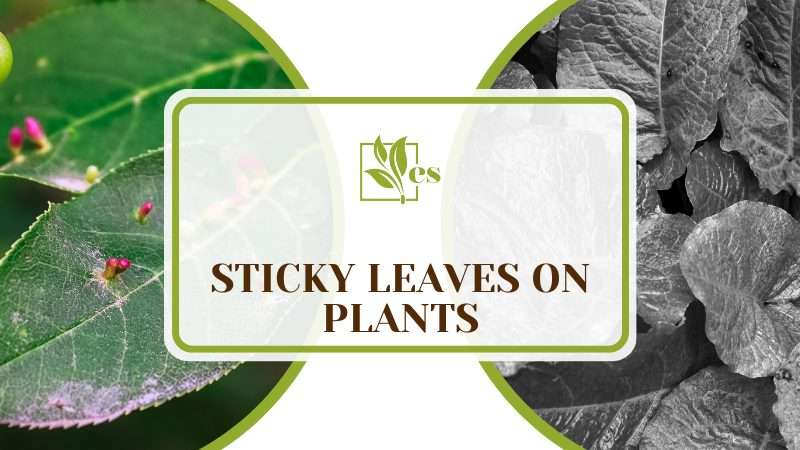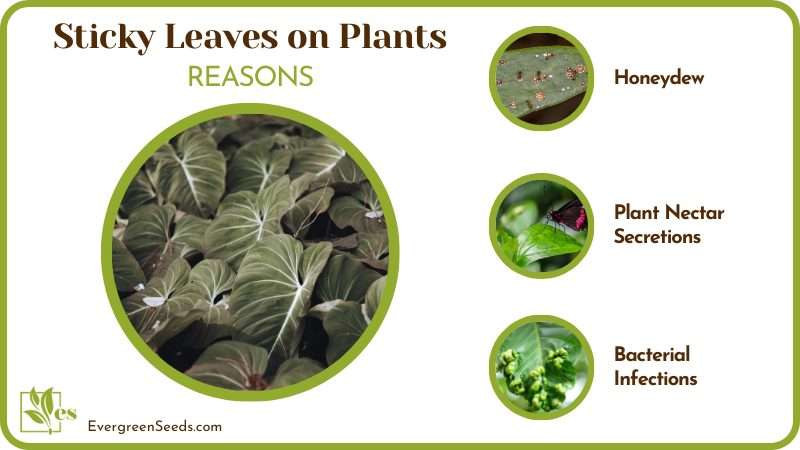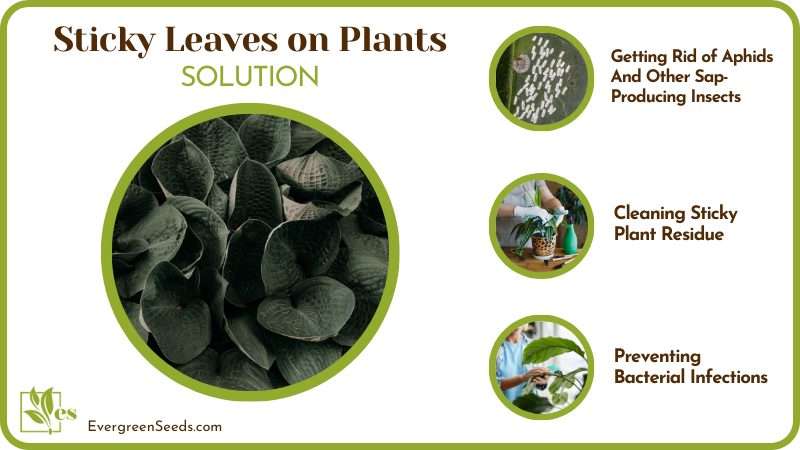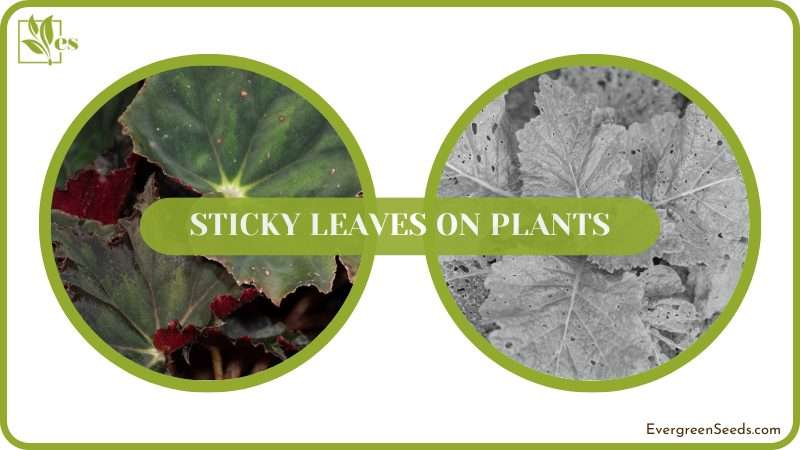Sticky leaves on plants – this is an issue you might be dealing with, and you’re probably wondering about the causes.

This common but unsightly phenomenon usually occurs with our houseplants, and it can be caused by insects such as aphids or natural plant secretions.
Luckily, this article is here to help you find out what’s bugging your plant and how to get rid of the root cause of your plant leaves getting sticky!
JUMP TO TOPIC
What Can Cause Plant Leaves To Become Sticky?
Insects can cause plant leaves to become sticky, but natural plant secretions can also have the same effect. By following the sap from where you’ve spotted it right to the source, you can safely determine if it’s a break in plant tissue or an infestation.
As mentioned, leaf stickiness can either be a natural occurrence on plants or can mean pest infestation. What will solve this puzzle is a close-up inspection. By recognizing the cause of the stickiness you can better determine how to resolve the situation. So, let’s see what the main causes of stickiness are before we can fix the main issue.
– Honeydew
Honeydew is often considered a disease in plants, but this is a secretion that aphids or scale insects leave on the indoor plant. If you can spot stickiness on plant leaves, but cannot identify the source, you probably have mealybugs, scale bugs, spider mites, or aphid insects to thank for this.
These insects are sap suckers. They feed on the nectar of the plants — they do this by attaching themselves to the phloem (the living tissue that transplants sugars throughout the plant) of the plant. They usually do that where the plant is weakest, which is usually the foliage. These insects rob the plant of essential sugars and elements, and the byproduct they leave behind is their poop or honeydew.
This sugary excretion often remains on plants and attracts other unwanted insects, such as ants, to the house plant. These other insects can then bring sooty mold and fungal diseases with them, and the desperate cycle continues. Get rid of this type of stickiness as soon as you spot it.

– Plant Nectar Secretions
Sometimes, plants themselves will be to blame for sticky leaves, and this will be a perfectly natural occurrence. Plants often excrete their nectars to fight off disease or particular pestilence bothering them. There are three reasons why plants will do this!
- For Protection
Plants have nectar secretion glands called extrafloral nectaries, and these are spread all over the green plant parts. Plants will often excrete nectars from these to protect themselves — by producing nectar, they attract ants and other friendly armies to protect the plant from predators. This is a survival tactic and is a non-infectious type of nectar bleeding and leaf stickiness.
- For Reproduction
Another situation where plants use their nectaries is one when there’s a need to reproduce. Plants are largely immobile beings, but they still need to find a way to spread their genetic material and reproduce. Besides the friendly ants, the nectar will attract some flying pollinators too! These will carry the plant’s pollen to others, encouraging pollination, and will in turn be rewarded with some juicy nectar.
- For Food Attraction
Some insects won’t have such a good time when attracted by nectar – especially when we talk about carnivorous plants! These plants aim to attract insects only to eat them and survive. The plants will excrete nectar and the unsuspecting insects will be eaten in turn.
– Bacterial Infections
Another case of a sticky situation on leaves is when the plant gets infected. Usually, we talk about bacterial or fungal infections when plants are cut and the wound is exposed to air and aerosol bacteria.
Some indoor plants that are most prone to these infections are usually big-leaved greens such as the pretty snake plants and Monstera plants. One of the most common diseases and infections attacking these is the Erwinia infection, triggered by a sudden flower rot. When this happens, the plant begins to smell and drops some leaves.
What is worrying about this type of infection is that it’s often mistaken for fungal disease and is treated the wrong way!
Fixing Stickiness on Your Plants the Easy Way
Fixing your leaves’ sticky issue will almost always come down to the type and cause of your sticky leaves, so first and foremost in resolving your situation is a close inspection of leaves and tracking the sticky material right down to the source, if possible.
Your sticky stuff issue will almost always fall into one of the three:
- Honeydew by insects
- Plant secretions
- Bacterial infections
Now that you’ve identified your problem, let’s see how you can resolve it.
– Getting Rid of Aphids And Other Sap-Producing Insects
It’s not only the plants that produce the sticky matter on their leaves. Some sap-producing insects can be responsible for honeydew and other sticky products hanging on the leaves.
Some of the most common culprits include scales, aphids, and mealybugs. There are some measurements and pest control protocols you can take when it comes to these but they may vary based on the type of insects your plants have been exposed to! In some cases, millipedes in your houseplants can cause similar issues.
If you’re dealing with scales, you’re probably looking at small and oval brown shells covering insects’ bodies. You can remove scales by hand, and cloth-wipe the leaf clean. Prep the cloth by dipping it in a mixture of water and rubbing alcohol! If the plant is too badly hurt, you will probably have to get rid of an entire plant to save the others.
Aphids, on the other hand, are soft-bodied insects that collect on the leaves’ undersides and suck the plant’s nectar directly from the phloem. If you’re dealing with aphids, insecticidal soap is your safest bet. Mix it with water and spray it directly on the plant too! These methods have proven time and again to be effective as they destroy the protective coating of these insects and lead to their dehydration and suffocation.
Mealybugs will appear as cotton stains on leaves. Neem oil is highly effective at combating these – controlling scale populations is achieved by using and applying a mixture of neem oil and dish soap with water.
You can call some other insects to the rescue! If you’re fine with having ladybugs around your house, they will eat almost all kinds of aphids and mealybugs from your plants.

– Cleaning Sticky Plant Residue
The sticky residue from the secretion of nectar or honeydew is easily removed with some home remedies.
Mix a tablespoon of any dish detergent or liquid hand soap with a quart of lukewarm water. Dip a cotton swab or a piece of cloth into the mixture and wipe the area clean. After this, you can use the dry end of a swab to dry the area. If you don’t have any detergent around, you can use rubbing alcohol too. Both of these will break down the sugars and make them easy to remove from your plant!
– Preventing Bacterial Infections
Bacteria will often gather and amass in areas where there’s plenty of moisture and no air circulation. These just love small places, so the first and foremost thing you can do when preventing bacteria from getting near your plants is to grow your houseplants in areas where there is plenty of light and ventilation!
Additionally, there are some other steps you can take to ensure your plants stay within a normal bacteria population range.
Avoid sudden changes and variations in soil acidity. Do not avoid regular watering by using only mist sprays. Try not to use high nitrogen fertilizer or use an excessive amount of it. When handling or pruning your plants, rub your tools in alcohol or bleach. Avoid placing your plants in high-humidity or high-temperature areas!













